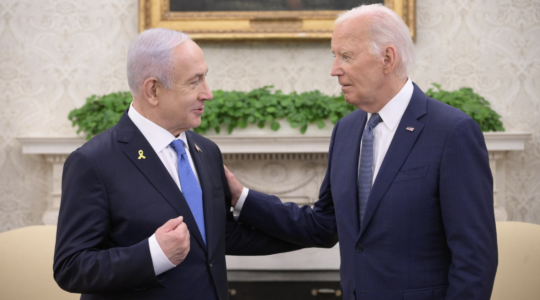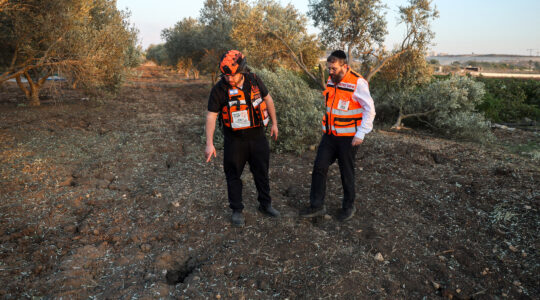JERUSALEM (JTA) – Was the Six-Day War a blessing or a curse for Israel’s place in the Middle East and its long-term survival?Forty years on, the jury is still out.In the war’s immediate aftermath, it seemed Israel’s sweeping victory would guarantee the Jewish state’s future and set the stage for a grand regional peace. But the war also unleashed powerful new forces that militated against a settlement of the core Israeli-Palestinian conflict and left simmering the overarching Israeli-Arab dispute. Today the parameters of the struggle have shifted, but comprehensive Israeli-Arab peace remains as elusive as ever and threats to Israel’s existence still give rise to concern. In the new equation the Arab world is split. As Israel seeks accommodation with the moderates, radicals in the Palestinian and wider Islamist camps conspire to quickly abort peace efforts.In June 1967, Israel emerged from six days of lightning strikes on three fronts a regional superpower that the Arab side no longer could realistically expect to destroy. The war also left Israel with large swathes of territory it could try to exchange for peace. Thus it seemed that the argument no longer would be about Israel’s existence but over the terms of accommodation. Israel’s Cabinet met shortly after the war and agreed to return territory in exchange for peace. The Arab League thought differently, however, meeting in Khartoum for its famous summit of the “Three No’s” – no recognition of Israel, no negotiations with Israel and no peace with Israel. Israel’s offer to return conquered territory, before the occupation had been established and before there were any settlements, was rejected.Still, “land for peace” quickly gained currency as the new international panacea. U.N. Security Council Resolution 242, passed five months after the fighting stopped, reflected the new approach. But that’s not how things worked out.The magnitude of Israel’s victory rekindled dormant messianic notions among religious Zionists. Before 1967, Israelis felt stifled by the weight of surrounding, hostile Arab states, and in the run-up to the war many feared impending physical annihilation. The fact that the victory was so decisive fueled speculation about divine intervention and the coming of the Messiah. Religious Zionists argued that returning parts of biblical Israel to the Arabs would delay the Messiah’s coming. These ideas gave rise to the religious settler movement, which advocated the settlement of “Greater Israel,” especially in the West Bank. The war also led to the rehabilitation of the secular Israeli right. Herut leader Menachem Begin – a virtual pariah during David Ben-Gurion’s Labor-led administrations from 1948 to 1963 – had been included in Levi Eshkol’s wartime national unity government. It was the first step on the path that Begin’s Likud Party took to power in 1977 in alliance with the religious Zionist movement. Both were dedicated to the integrity of the entire land of Israel and opposed to Palestinian statehood. Concurrently the war spurred a new, militant Palestinian nationalism determined to wrest control of Palestinian decision-making from Arab states like Egypt and Jordan and opposed to any recognition or accommodation with Israel. Founded several years before the war, in 1964, the Palestine Liberation Organization under Yasser Arafat embarked on a campaign of terror against Israel, advocating the establishment of a “secular democratic” state in Israel’s stead. The twice-defeated Palestinians continued to demand control of Jerusalem and the “right” of Palestinian refugees to return to Israel proper. Accommodation between these powerful new forces of Israeli and Palestinian nationalism seemed impossible. Still, the war altered the regional balance, opening up possibilities for peacemaking despite the difficulties. The United States, which until 1967 had been wary of getting too close to Israel, forged a strategic alliance with the Jewish state, becoming its main weapons supplier and diplomatic backer as well as a major trading partner. The Arab failure in the war – seen in part as a failure of Soviet arms and support – marked the beginning of the decline of Soviet influence in the region. This change in the regional superpower balance created the conditions for Israeli-Egyptian peace, mediated by the Americans, in the late 1970s. Israel’s occupation of Palestinian-populated territory precluded further peacemaking, however. Indeed, the occupation was the most bitter legacy of Israel’s 1967 victory on the battlefield. According to some military experts, decades of policing the occupation eroded the army’s battle proficiency over time and was partly responsible for the ground forces’ poor performance in last summer’s Lebanon War. The occupation also proved a public-relations disaster. Worse, during the second Palestinian intifada that began in 2000, the ongoing occupation led to renewed calls for a binational state with an eventual Palestinian majority, which would mean the end of Israel as a Jewish state. The Oslo peace process of the 1990s was a serious attempt to end the occupation and transform the results of the 1967 war into an Israeli-Palestinian peace deal based on two peaceful, neighboring states. As it implied an end to occupation, the 1993 Oslo framework agreement also paved the way for a peace deal between Israel and Jordan. The unraveling of the Oslo process after the failure of the Camp David summit in July 2000 and the radical Islamic attack on America on Sept. 11, 2001, exacerbated the moderate-radical divide in the Arab world and among the Palestinians. Given the weakness of the moderates and the intransigence of the radicals, in 2005 Israel began a unilateral withdrawal from territory occupied in 1967. The idea was to create conditions for an eventual two-state solution and pre-empt the growing threat to Israel’s existence from the revived one-state idea. The limited success of the 2005 Gaza withdrawal and the ongoing occupation of the West Bank leave Israel still grappling with the bittersweet legacy of the Six-Day War. Two of the main 1967 belligerents, Egypt and Jordan, are helping to promote an agreement with moderate Palestinians that Foreign Minister Tzipi Livni says will entail further Israeli withdrawals from the West Bank. On the other side of the Muslim divide, Palestinian and Islamic rejectionists, primarily Hamas and Iran, are working to undercut any potential progress, pleased to see Israel weighed down by the occupation. The Israeli government strategy is to bypass Hamas with help from the moderates. However, critics argue that the moderates either aren’t really so moderate or won’t be able to deliver, and that the best Israel can hope for is an interim agreement – negotiated with Hamas or with Hamas’ approval – that significantly reduces the amount of territory Israel occupies. Settlers and other right-wingers see in both these strategies a sellout that may gain Israel some breathing space but which will boomerang sooner or later, with devastating effect. Forty years on, it seems, Israel remains saddled with the results of its great victory in 1967, unable either to swallow the territories or to reject them.

Help ensure Jewish news remains accessible to all. Your donation to the Jewish Telegraphic Agency powers the trusted journalism that has connected Jewish communities worldwide for more than 100 years. With your help, JTA can continue to deliver vital news and insights. Donate today.





